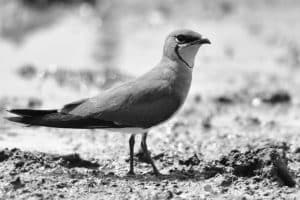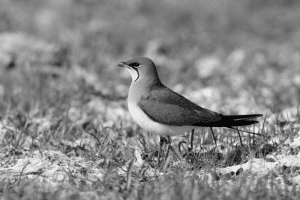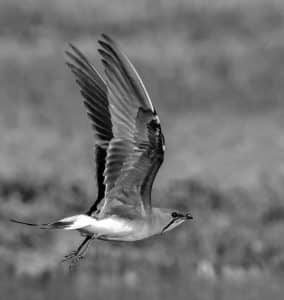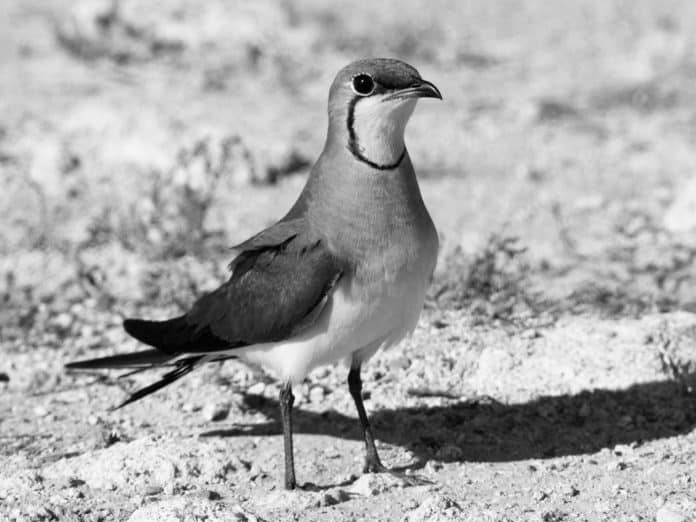Introduction to the Collared Pratincole
The collared pratincole (Glareola pratincola) is a fascinating bird species that can be found in the beautiful country of Tanzania, located in East Africa. These birds are known for their incredible aerial acrobatics and are a sight to behold as they gracefully glide through the air. In this article, we will explore the habitat, physical characteristics, behavior, migration patterns, conservation status, research efforts, and the best places to spot collared pratincoles in Tanzania.
Habitat and Distribution of the Collared Pratincole in Tanzania

Collared pratincoles are primarily found near freshwater lakes and wetlands in Tanzania. They prefer habitats with shallow water and abundant vegetation, which provide them with an ample supply of insects, their main food source. Some of the lakes in Tanzania where collared pratincoles can be spotted include Lake Manyara, Lake Eyasi, and Lake Natron. These lakes offer the perfect environment for these birds to thrive, with their diverse ecosystems and rich biodiversity.
The distribution of collared pratincoles in Tanzania is not limited to specific regions but can be found throughout the country. However, they are more commonly observed in the northern and eastern parts of Tanzania, where there are numerous lakes and wetlands. These birds are known to be highly migratory, and during the breeding season, they can be found in Europe and Asia as well.
Physical Characteristics and Behavior of the Collared Pratincole
Collared pratincoles are medium-sized birds, measuring around 25-30 centimeters in length. They have long, pointed wings and a streamlined body that allows them to swiftly maneuver through the air. The name “collared” pratincole comes from the distinctive black collar around their neck, which is a unique feature of this species. Their plumage is predominantly brown with a white belly, and they have a red bill and legs.
These birds are highly sociable and often form large flocks, especially during migration. They are known for their aerial foraging behavior, where they catch insects in mid-air using their agile flight skills. Collared pratincoles are also territorial during the breeding season and perform elaborate courtship displays to attract mates. Their calls are a melodious mix of whistles and chattering sounds, which can be heard during their breeding season.
Migration Patterns of the Collared Pratincole
Collared pratincoles are remarkable migratory birds, traveling long distances in search of suitable breeding and feeding grounds. During the breeding season, which typically starts around April, these birds leave their wintering grounds in Africa and embark on a journey to Europe and Asia. They travel thousands of kilometers, crossing vast deserts, mountains, and seas, to reach their breeding grounds.
Once the breeding season is over, collared pratincoles make their way back to Africa, where they spend the winter months. The return migration usually takes place around September or October. It is truly awe-inspiring to witness these birds navigate such vast distances and overcome various obstacles during their migratory journeys.
Conservation Status and Threats to the Collared Pratincole

The collared pratincole is classified as a species of “Least Concern” on the IUCN Red List, which means that it is not currently facing any significant threats to its survival. However, like many bird species, collared pratincoles are vulnerable to habitat loss and degradation. The destruction of wetlands, pollution, and climate change pose potential risks to their populations.
Efforts are being made to conserve the habitats of collared pratincoles in Tanzania. Organizations and local communities are working together to raise awareness about the importance of protecting these birds and their habitats. These conservation initiatives aim to ensure the long-term survival of collared pratincoles and maintain the ecological balance of the lakes and wetlands in Tanzania.
Collared Pratincole Research and Monitoring Efforts in Tanzania
To better understand the ecology and behavior of collared pratincoles, researchers and conservationists in Tanzania have been conducting various studies and monitoring programs. These efforts involve tracking the migration patterns of the birds using satellite tags and banding individuals to gather data on their movements and survival rates. Researchers also study their breeding behaviors, diet, and habitat preferences to gain insights into their ecological needs.
Monitoring and research efforts play a crucial role in the conservation of collared pratincoles. By collecting data and identifying potential threats, researchers can provide valuable information for the development of targeted conservation strategies. These efforts also contribute to the overall understanding of bird migration and the importance of preserving the habitats that these birds rely on.
Best Places to Spot Collared Pratincoles in Tanzania
If you’re an avid birdwatcher or simply interested in observing collared pratincoles in their natural habitat, Tanzania offers several prime locations for sightings. Lake Manyara National Park is known for its diverse bird population, and collared pratincoles can often be seen along the lake’s shoreline. Lake Eyasi and Lake Natron are also excellent places to spot these birds, especially during the breeding season.
When visiting these areas, it’s important to respect the birds’ space and observe them from a distance. Binoculars or a camera with a telephoto lens can help you get a closer look without disturbing their natural behavior. Remember to follow ethical guidelines for wildlife observation and ensure that your presence does not disrupt the birds’ activities.
Tips for Observing and Photographing Collared Pratincoles

Observing and photographing collared pratincoles can be a rewarding experience. Here are a few tips to enhance your chances of a successful sighting:
- Choose the right time: Collared pratincoles are most active during the early morning and late afternoon when they are foraging for insects. Plan your visit accordingly to maximize your chances of seeing them in action.
- Be patient and still: Birds can be easily startled, so it’s important to remain calm and avoid sudden movements. Find a comfortable spot, settle in, and wait quietly for the birds to come closer.
- Bring the right equipment: A pair of binoculars or a camera with a telephoto lens will help you observe and capture the birds’ behavior without getting too close. Make sure to pack spare batteries and memory cards for extended observation periods.
- Study their behavior: Spend some time familiarizing yourself with the collared pratincoles’ behavior and flight patterns. This will enable you to anticipate their movements and capture unique shots.
Remember, the welfare of the birds should always be the top priority. Avoid disturbing their nesting sites or interfering with their natural behavior. By following these tips, you can have a memorable and respectful encounter with collared pratincoles.
Other Bird Species Found in the Same Habitats as Collared Pratincoles
The lakes and wetlands of Tanzania are home to a diverse array of bird species, many of which share the same habitats as collared pratincoles. Some notable species that can be spotted in these areas include:
- Lesser Flamingo (Phoeniconaias minor): These elegant birds are known for their vibrant pink plumage and can often be seen in large flocks around the lakes of Tanzania.
- African Fish Eagle (Haliaeetus vocifer): With its striking appearance and distinctive call, the African Fish Eagle is a common sight near lakes and rivers, where it hunts for fish.
- Grey-headed Gull (Chroicocephalus cirrocephalus): These gulls are known for their gray plumage and can be seen scavenging for food along the shores of lakes and wetlands.
- Pied Kingfisher (Ceryle rudis): This small, black-and-white kingfisher can be observed hovering above the water before diving in to catch its prey.
These are just a few examples of the many bird species that coexist with collared pratincoles in Tanzania. Exploring the rich avian diversity of these habitats can provide a rewarding and immersive wildlife experience.
Conclusion and the Importance of Protecting Collared Pratincoles in Tanzania
The collared pratincole is a remarkable bird species that adds to the rich biodiversity of Tanzania. Their aerial acrobatics and graceful flight patterns make them a captivating sight for birdwatchers and nature enthusiasts. However, their habitats and populations face various threats, such as habitat loss and degradation.
It is crucial to raise awareness about the importance of protecting collared pratincoles and their habitats in Tanzania. By supporting conservation efforts, promoting sustainable tourism practices, and advocating for the preservation of wetlands and lakes, we can ensure the long-term survival of these magnificent birds.
So, next time you visit Tanzania, keep an eye out for the collared pratincoles and other bird species that call this country home. Take a moment to appreciate their beauty and learn from their resilience. Together, we can make a difference in safeguarding the natural heritage of Tanzania and preserving the aerial acrobats of the lakes in East Africa.

































